Physical Address
304 North Cardinal St.
Dorchester Center, MA 02124
Wound healing and the final surgical result depend on the anatomic location, structure of the skin and its functional interaction with underlying elements of the region.
Anticipation of the dynamic tension exerted on free margins of the eyelid, nasal rim, helix of the ear, and lip helps in planning the procedure to preserve the regional anatomy.
The cosmetic units of the face and skin tension lines are used to plan a procedure.
Knowledge of the sensory nerves is necessary for effective regional nerve blocks.
The depth of the initial incision, the proper level of undermining, and placement of sutures depend on knowledge of the underlying anatomy.
Knowledge of the regional anatomy and its drainage by the lymphatic system is important for assessment of melanoma, squamous cell carcinoma, and other aggressive cutaneous malignancies.
Feeling comfortable with regional anatomy promotes competency in performing surgical procedures. Regional anatomy is integrated into chapters when understanding the anatomy is relevant to the surgical procedure. For example, the superficial musculoaponeurotic system (SMAS) is described in the chapter discussing layered facial closures with plication of the SMAS ( Chapter 14 ). In some instances, the topographic anatomy is provided only in the chapter with the surgery of the specialized unit. For example, nail unit surface topography and anatomy of the distal phalanx are provided with nail surgery ( Chapter 47 ); and the anatomy of the superficial and deep venous system of the leg is with sclerotherapy for leg veins ( Chapter 36 ). Regional topographic anatomy that is not included in other chapters is provided in this chapter, thus the terminology used to describe surface features of the ear, nose, lips, genitalia, hands, and feet is included in this chapter. A figure from this chapter may be repeated in subsequent chapters in order to inform the description of the surgical procedure. For example, the topographic landmarks and components of the periorbital region are included in the description of blepharoplasty.
Planning surgical procedures depends upon a working knowledge of anatomy. The decision to perform surgery requires assessment of the risks and benefits of the procedure for the individual patient. The anticipated final appearance is, in part, determined by the regional anatomy and the functional interaction of the skin with underlying anatomic features. The cosmetic units of the face; location of free margins of the eyelid, nasal rim, helix of the ear, and lip; and skin tension lines are used to plan the procedure. In addition, flaps are designed to prevent persistent postoperative lymphedema. Providing safe and sufficient anesthesia requires knowledge of the sensory nerves to allow for effective regional nerve blocks. Superficial topography, also known as the surface landmarks, is used to locate underlying blood vessels, sensory and motor nerves, and lymphatic ducts. The level of undermining used to mobilize tissue requires an understanding of the horizontal arrangement of the cutaneous, muscular, and fascial soft tissue planes. Suture placement requires both vertical and horizontal orientation to the tissue. It is critically important to know the drainage pattern of the lymphatic system, which must be examined for cutaneous metastasis of melanoma, squamous cell carcinoma, and other aggressive cutaneous malignancies.
While most of the skin's biomechanical properties are derived from dermal collagen and elastin, the subcutaneous fat, blood vessels, and nerves play a role in the skin's functional biomechanics. While the epidermis has almost no biomechanical role, the dermoepidermal junction is important to wound healing ( Fig. 1.1 ).
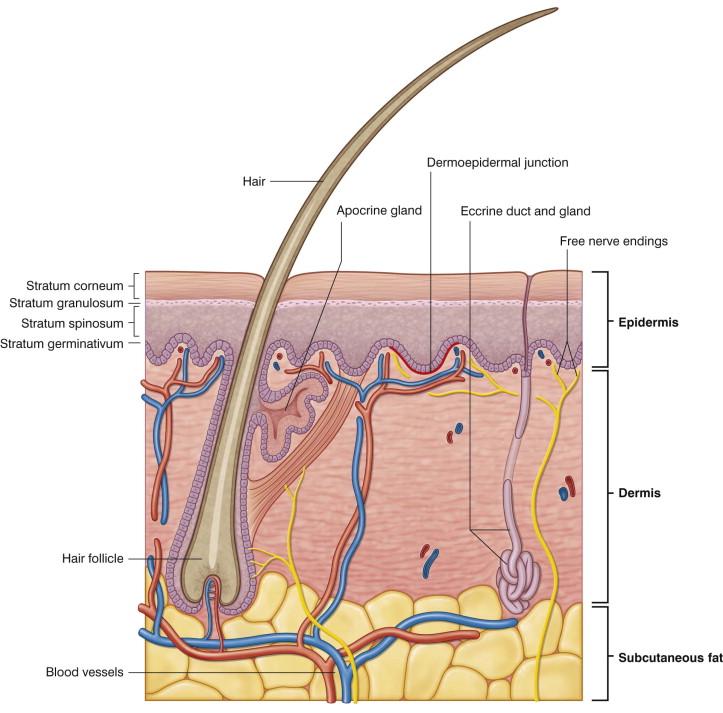
The outermost layer of the skin, the epidermis, is a continuous self-regenerating layer of stratified squamous epithelium varying in thickness from 0.04 mm on the eyelids and genitalia, to 1.5 mm on the palms and soles. The stratum germinativum, or basal cell layer, is composed of a single row of columnar epithelial cells arranged with their long axes perpendicular to the dermoepidermal junction. The basal keratinocytes are the active stem cells that proliferate heterogeneously and maintain homeostasis by balancing proliferation (S phase) and non-cycling (G0, G1, G2 phase) cells. Non-cycling stem cells can be recruited by wounding.
While there may be differences from one person to another for eyelid skin, the thickness of the facial skin of any one person may be expressed as how many times thicker it is than eyelid skin. For example, nasal tip skin is 3.30 times thicker than eyelid skin, the nasal dorsum is 2.92 times thicker, and the brow/forehead is 2.8 times thicker. This ratio uses the epidermal and dermal thickness of eyelid skin as the reference unit for comparison. Skin thickness varies with age, race, gender, and the degree of photodamage. An understanding of the relative thickness of the skin helps the surgeon closely approximate the original characteristics of the skin when planning a repair.
The dermis is a flexible, intricate, connective tissue network of collagen and elastin fibers embedded in a ground substance matrix that accommodates nerve bundles, sensory receptors, lymphatic channels, and vasculature. Beneath the dermoepidermal junction, collagen, especially collagen type I, constitutes 75% of the dermis. In the adventitial and papillary dermis, collagen fibers are loosely arranged and form a fine meshwork, whereas in the reticular dermis, they are assembled into thick interwoven bundles. Elastic fibers constitute approximately 3% of the dermis by dry weight, measure 1–3 mm in diameter, and play a major role in skin elasticity and resilience. Elastic fibers are confined to the lower portion of the dermis, where they are arranged parallel to the epidermis. The third component of the dermis is the ground substance, an amorphous material that fills spaces between the fibrillar and cellular components of the dermis, imparting turgidity and resilience. In human skin, the dermal matrix consists of glycosaminoglycans (hyaluronic acid and dermatan sulfate) and glycoproteins. Fibronectin, the major filamentous glycoprotein component of the dermal matrix, is produced by fibroblasts. Fibronectin ensheaths collagen and elastin bundles and plays a role in the attachment of keratinocytes to the basal lamina, which is important in wound healing.
The intrinsic elasticity of the skin, its “stretchability,” is an important characteristic to understand during wound closure. In areas where the dermis is relatively inflexible and lacks elasticity (back, scalp), even small degrees of tissue rotation may result in protrusion of the pivot point, whereas in areas where the skin possesses significant elasticity (young facial skin), larger angles of rotation are absorbed without causing protrusion. Lifting and stretching the skin between the surgeon's index finger and thumb is a helpful means for estimating the elasticity of the skin before wound reconstruction.
In comparison with static materials such as steel, skin's stress–strain relationship varies over time and is not a linear relationship ( Fig. 1.2 ). Intrinsic tissue elasticity is related to the patient's age, amount of photodamage, and anatomic site. In general, younger patients possess greater tissue elasticity for a given anatomic site than older patients. Markedly photodamaged skin possesses less elasticity than photoprotected skin. In some anatomic sites, such as the back of the hand or elbow, the skin is easily movable but quite inelastic. In inelastic skin such as the scalp, even a 30° angle of closure may produce noticeable tissue protrusion.
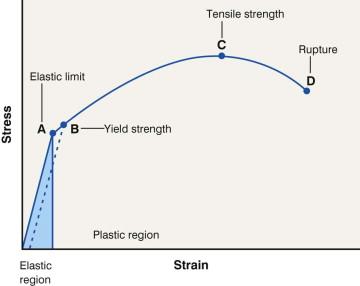
Biomechanical properties determine the tissue response to intraoperative conditions. These properties are measured by stress, elasticity, creep, and stress relaxation. Stress (load) can be defined as force delivered to a cross-sectional area. Strain is the change in length in comparison to the original length. The load versus length relationship is the stress–strain curve ( Fig. 1.2 ). During the initial stages of loading, the material deforms in direct proportion to the stress, as seen by the early straight-line relation between stress and strain. The slope of this curve up to point A, the elastic region of the stress–strain curve, is Young's modulus or the modulus of elasticity (E). The equation of this line, Hooke's law, is σ = Ee, where σ is defined as stress and e is defined as strain. Materials with larger E values are stiffer or more rigid than those with low E values.
A material loaded with stress beyond point A will not completely return to its original shape after removal of the stress. Point A represents the elastic limit. Loading beyond point A produces permanent deformation; this region of the curve is the plastic region. As the stress is removed, the elastic portion recovers along a line parallel to the original slope ( Fig. 1.2 , dashed line), leaving permanent deformation. The limit of usable elastic behavior is defined as point B, the yield strength. As loading continues into the plastic region, the increasing stress does produce increasing strain, but not in a linear fashion ( Fig. 1.2 , points B and C). The specimen elongates on continued application of the load until the point is reached at which the specimen is unable to adapt enough to continue to support the load ( Fig. 1.2 , point C, tensile strength). The region from B to C demonstrates that the stretchability of skin is non-linear. Stress relaxation most likely occurs because of breakage of collagen fibers. After the maximal load is exceeded, the specimen elongates rapidly and rupture occurs ( Fig. 1.2 , point D). Obviously, during intraoperative loading of the skin, the surgeon seeks to maximize the stress to produce the greatest strain that can be tolerated by the skin. Thus the region of this curve BC must be used to optimal advantage, but the load should not exceed the tensile strength of the skin or the tissue will slip into the portion of the curve CD that leads to rupture.
Movement of the skin is characterized by its ability to stretch over time (creep). Mechanical creep occurs when the skin is stretched at a constant force and eventually contributes to skin deformation. The constant force results in extrusion of tissue fluid from the interstices of the collagen network and stretching of skin beyond its inherent extensibility. The stretching achieved during mechanical creep does not retract intraoperatively. At a certain point in the stress–strain curve, there is almost complete relaxation (stress relaxation), which is most likely because of the breakage of collagen fibers; however, after this point, additional undermining will not reduce closure tension, but will increase the risk of hematomas or nerve damage.
Closing a wound without tension can be achieved by intraoperative loading with a constant force, such as placing temporary retention sutures (pulley stitch) for about 15 min. Another way of achieving mechanical creep is by load cycling, which is performed with strong traction exerted with skin hooks at 3-min intervals over four cycles. When stretched skin is anchored to a fixed point by suspension sutures, the elastic fibers do not revert to their original state. Intraoperative tissue expansion can also be performed by closing the wound using the rule of halves. Each suture progressively reduces the tension across the wound as the surgeon takes advantage of tissue creep. Tissue stretching affects the skin's microcirculation with a combination of narrowing of the lumina of blood vessels and shearing fractures. This tension also may result in venous congestion with subsequent compromise of healing. Highly vascularized regions are better able to withstand tension than poorly-perfused ones that may undergo necrosis. “Stretch-back” describes the subsequent spreading of scars for wounds closed under tension. Most of the spreading of the scar occurs during the first 8 postoperative weeks and is completed at 12 weeks. On the scalp, upper back, and deltoid region, the benefits of excision for aesthetic indications is compromised by scar spreading. It is important to be aware of the capacity for stretch-back before planning the surgery.
Significant variations in the skin of the head and neck and the relationship to underlying adipose tissue, cartilage, and bone occur within dramatically short distances of a few centimeters of the scalp, eyelids, lips, and chin ( Fig. 1.3 ). The scalp is divided into five layers that are identified by the mnemonic “SCALP”, which describes the layers from superficial to deep as S, s kin; C, sub c utaneous tissue; A, a poneurosis (galea); L, l oose connective tissue; and P, p eriosteum. The cutaneous nerves and vessels of the scalp are in the dermal skin layer with larger vessels in the subcutaneous fat. There are virtually no vessels in the subgaleal space of loose connective tissue, which makes it the ideal plane to undermine scalp tissue. However, scattered emissary vessels that are transmitted through the skull are occasionally encountered and must be planned for during scalp surgery. All nerves and vessels of the scalp originate below the level of the brow as it is extended circumferentially around the scalp. No motor nerves are found on the scalp.

The fibrous bands connecting the dermis to the aponeurosis or fascia on the face and the body are accentuated in the scalp. During surgery in the subcutaneous fat of the scalp, there is significant resistance to lateral movement and substantial undermining has to be performed to close even small wounds. The rich vascular supply of the scalp means that undermining in the subcutaneous tissue is routinely associated with heavy bleeding. To mitigate this problem, most dermatologic surgeons carry their incision through the galea. Because the galea is so inelastic, the underside of it may be scored (galeatomy) to enhance its ability to stretch over the periosteum to close the defect. The galea is an aponeurosis connecting the frontalis muscle of the forehead with the occipitalis muscle of the posterior scalp, which is why the area is referred to as one structure, the occipitofrontalis muscle. The galea extends from the superior occipital line to approximately 2 cm below the frontal hairline on the forehead where it interdigitates with the SMAS.
The skin of the eyelids, which is the thinnest on the entire body, has a rich vascular supply and no subcutaneous fat. The skin lies directly on the muscle, with a minimal or no fatty layer. Caution is needed when making incisions because even an incision limited to a few millimeters is relatively deep here. Without the protective buffer of fat that exists in other areas, there is the possibility of the novice incising too deeply and inadvertently injuring the orbital septum and entering the highly vascular retro-orbital fat.
As in the periorbital area, the voluntary muscles of the perioral and chin area insert directly into the skin, which is why dynamic (animation) wrinkles in these areas are so prominent. The muscles are thick and large, especially on the chin, and undermining is often difficult and associated with increased bleeding. Blunt dissection on the chin is often hampered by the presence of the diagonally and vertically inserting muscular fibers and minimal subcutaneous space to dissect within. By contrast, the skin of the lateral cheeks has no direct muscle insertions and blunt undermining in subcutaneous tissue can be carried out with minimal effort.
In the postauricular area, anterior to the mastoid area, the fatty layer is often very thin. The most posterior aspect of the parotid gland is in this area and protects the facial nerve. The gland is grayish-tan in color and a bit denser in consistency than adipose tissue and must be avoided.
Boundaries or junctions of anatomic units on the face including the nasolabial fold, the nasofacial sulcus, the mentolabial crease, and the preauricular sulcus form some of the contour lines of the face. Other examples are eyelid margins, philtral columns, nasal contours, the vermilion border, and eyebrows. These junction lines divide the face into cosmetic units ( Figs 1.4–1.9 ). It is important that these boundaries are respected as much as possible during surgery. Other facial contour lines are wrinkles, which are best delineated in the seated and animated patient. Age and sun exposure can accentuate the wrinkles that appear along the course of the relaxed skin tension lines. These lines generally occur perpendicular to the long axis of the underlying musculature.


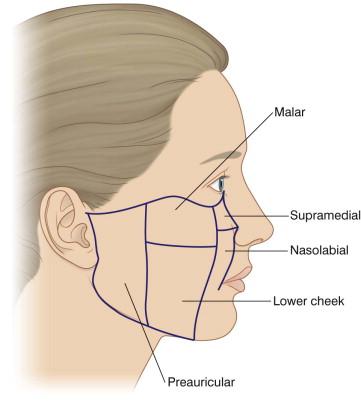
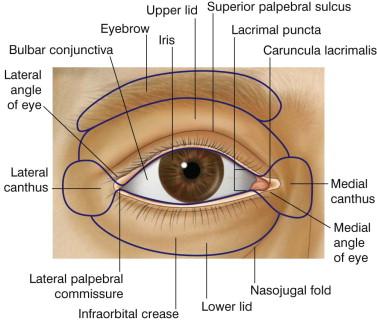
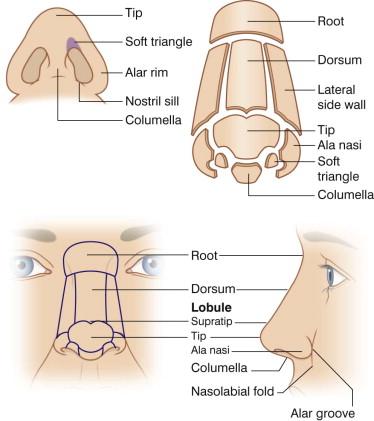

The major aesthetic units of the face (the forehead, nose, eyes, lips, cheeks, and chin) ( Figs 1.4–1.9 ) are subdivided into units whose skin surface attributes are consistent within the unit. Surface characteristics such as pigmentation, texture, hair quality, pore size, sebaceous quality, and response to blush stimuli are similar within a single unit. Elasticity and mobility of the skin may vary within a unit. The boundaries of these cosmetic units may provide good places to electively place incisions. For instance, the junction of the nose and medial cheek (the nasofacial sulcus) provides a natural line of definition along which an incision may be camouflaged. These cosmetic units also reflect the surface anatomy with differences in the three-dimensional contour providing demarcation of the units. Terminology evolves to meet clinical demands, thus the lip region is now classified in 15 anatomic zones to better direct placement of injectable fillers ( Fig. 1.9B ).
Volume changes in the skin and soft tissue contribute to age- and disease-related facial reshaping. Gravity determines the direction of facial tissue festooning but is not the cause of the tissue deflation. The soft tissue is draped over the craniofacial support system; therefore, bone reabsorption due to aging is the major contributor to the appearance of the aging face. As the aging mandible becomes smaller, the cosmetic unit of the cheek and chin becomes prominent, thus the perioral area has the appearance of a puppet – Marionette lines. With thyroid associated orbitopathy, the dermal and subdermal tissues are infiltrated, the eyebrow region becomes thickened and coarse. There is a change in the shape of the brow with a lateral flare or “C” shape and a rounded bulge of tissue between the lateral brow and the temporal fossa. Surgical rehabilitation of these patients requires eyebrow remodeling with sculpting of the eyebrow fat.
The inherent properties of the dermal collagen and elastic tissue of skin in various regions combined with the tension intermittently exerted on it by the underlying muscles results in linear wrinkles ( Figs 1.10–1.12 ). Over the years, stretching of the collagen in the direction of the pull of the muscles produces wrinkles. The elastic tissue is able to maintain the smooth shape of the skin; however, as the skin loses its elasticity with age, the redundant skin ripples into wrinkles and folds. The linear wrinkles on the face form along the attachments of the fibers of the SMAS. When fibrous attachments of the skin to the underlying muscle do not exist, gravitational forces pull the skin into baggy areas, such as: infraorbital festooning, medial cheek jowling, and “turkey gobbler” neck deformity.

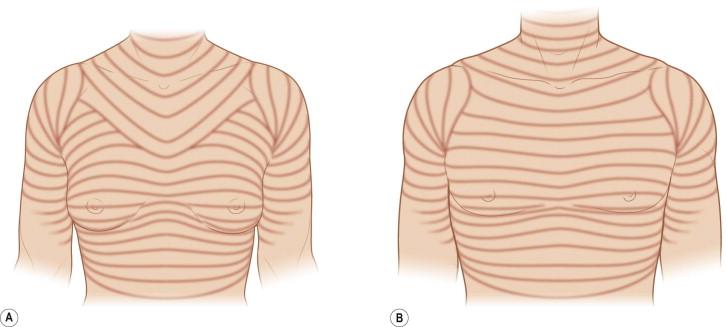
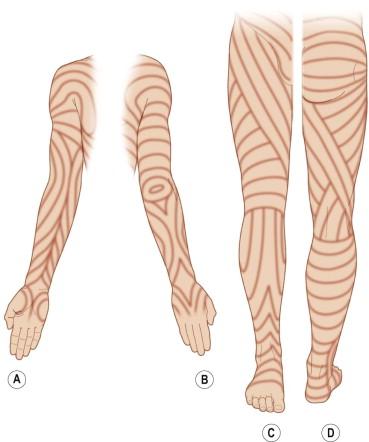
While areas of sagging skin are not produced solely by fat deposits, fat deposits do play a role in the contours of the face. The face consists of individual fat compartments that gain and lose fat at different rates. Malar fat is composed of three separate fat compartments: medial, middle, and lateral temporal cheek fat. The chin or mental fat compartment is well demarcated from the adjacent compartments of the submental area and the jowl by retaining ligaments. The ligaments vary from being well-developed to absent.
The surface anatomy of the face is best appreciated by referring to the bony landmarks of the frontal, maxillary, zygomatic, and mandibular bones. Each of these bones has distinctive features that contribute to the surface landmarks of the face – the orbital rims, zygomatic arch, the mastoid process, and the mentum.
The zygomatic arch is the most prominent bone of the lateral cheek. The posterior aspect of the arch helps to define the superior pole of the parotid gland, the superficial temporal artery, and some branches of the facial nerve. The mastoid process is the most inferior portion of the temporal bone and is easily palpated as a rounded projection at the inferior aspect of the postauricular sulcus. It is the landmark for identification of the emergence of the facial nerve trunk. In the adult, the mastoid process protects the facial nerve as it exits the skull through the stylomastoid foramen. The mastoid process is not fully developed until puberty, during which time the facial nerve is not fully protected. The mental protuberance of the mandible forms the prominence of the chin. The body of the mandible supports the teeth and presents a sharp inferior margin of the lower face.
The portion of the frontal bone forming the forehead has rounded projections (frontal eminences). The superciliary arches deep to the eyebrows are prominent ridges with a small elevation between the two arches (the glabella). The nasion is formed by the articulation of the paired nasal bones with the frontal bone (see Fig. 1.14 ).
The three important foramina in the facial bones can be identified from the surface (see Box 1.1 ). The supraorbital, infraorbital, and mental foramina are found along a vertical line extending from the supraorbital foramen or notch and passing through the center of the pupil ( Fig. 1.13 ). The supraorbital foramen is 2.5 cm or approximately one thumb-breadth from the midline of the nasal root. It can be palpated immediately above the orbit as a notch on the underside of the orbital rim. From this notch the supraorbital artery, vein, and nerve emerge from the skull.
Preserve the cosmetic units of the face. Remove additional tissue to place incisions at the junction of cosmetic units; use suspension sutures to fix advancing tissue to underlying support to prevent distortion of the free margins of the lip and eyelid.
Place incisions into relaxed skin tension lines. With the patient seated, observe the formation of lines with animation of the face (e.g., grimace, frown, smile, pucker).
Place suspension sutures into deep supporting structures: the mental crease, nasolabial fold at the junction with the alae, the zygomatic arch, the orbital rim.
Mobilize tissue. Plan tissue movement to access the lax tissue of the temple, nasolabial fold, paranasal cheek, supraorbital and infraorbital lids, glabella, neck; use cycles of intraoperative loading with skin hooks on the skin of the wound edges to produce stress relaxation; temporary retention sutures place constant force on the wound edges.
Reduce the wound size. Undermine tissue widely in a tissue plane that results in the least amount of bleeding and plicate the SMAS.

The infraorbital vessels and nerve pass through the infraorbital foramen, which is found in the maxillary bone below the infraorbital rim. In non-obese people, it can usually be palpated as a small opening 1 cm below the infraorbital rim on the backward slope of the maxilla and superolateral to the nasal ala. While the mental foramen is not usually palpable, it is typically present at the mid-portion of the mandible along the same vertical line from the supraorbital foramen ( Fig. 1.13 ). With age, there is a reduction in the height of the mandible; the mental foramen may therefore assume a more superior location. In patients with dentures, the position of the foramen is best located by measuring about 1 cm from the inferior margin of the mandible superiorly along the midpupillary line.
A series of measures and angles form the points of reference for aesthetic planes, which attempt to codify the ideal parameters of beauty and proportion of the face. The ancient Greeks started this codification and the works from antiquity became available in the Renaissance. Leonardo da Vinci appears to have created the earliest known diagram of the facial circle ( c. 1490–1492). In this circle of the profile of the face, the trichion (hairline), pronasale (nasal tip), and pogonion (anterior projection of the chin) fall along an arc ( Fig. 1.14 ). A line from the tragion of the ear to the pronasale forms the radius of the arc. Pleasing facial proportions divide the face into relatively equal thirds. The upper face is measured from the trichion (the anterior hairline) to the glabella (which delineates the most prominent projection of the forehead at the eyebrows). The middle-third of the face extends from the eyes and nose at the glabella to the subnasale (the inferior aspect of the nose at the junction of the columella and the cutaneous upper lip). The lower-third extends from the subnasale to the menton (the lowest point on the chin contour of the mandible).
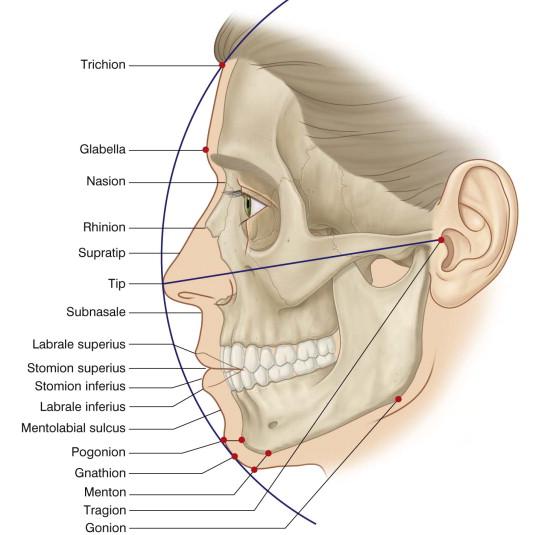
The face divides vertically into fifths, with each segment being equal to the width of the eye measured from the medial to lateral contours. The width of the eye equals the distance between the eyes (inner canthal distance); the distance from the lateral canthus to the outer rim of the helix of the ear in a full frontal view; and the width of the nose from ala to ala ( Fig. 1.15 ). The central facial dimensions are further related by the interpupillary distance (solid line A), being equal to the vertical distance between the medial canthi and the most inferior point of the vermilion of the upper lip (the stomion superius; solid line B).

The ideal brow is defined by two lines: one drawn from the lateral alar rim to the outer canthus of the eye which continues on to the lateral tail of the brow. The other line, drawn obliquely from the lateral alar rim through the medial canthus to the brow, defines the highest point of the brow arch. The lips ideally extend from the medial limbus of one eye to the medial limbus of the other. A slanted line connecting the highest point of the upper lip at Cupid's bow with the most lateral aspect of the vermilion border of the upper lip should parallel a line connecting the mid and highest point of the supracanthal fold of the eyelid and the lateral-most border of this fold. These landmarks can be helpful to achieve the most aesthetically pleasing results during facial reconstruction surgery.
Become a Clinical Tree membership for Full access and enjoy Unlimited articles
If you are a member. Log in here